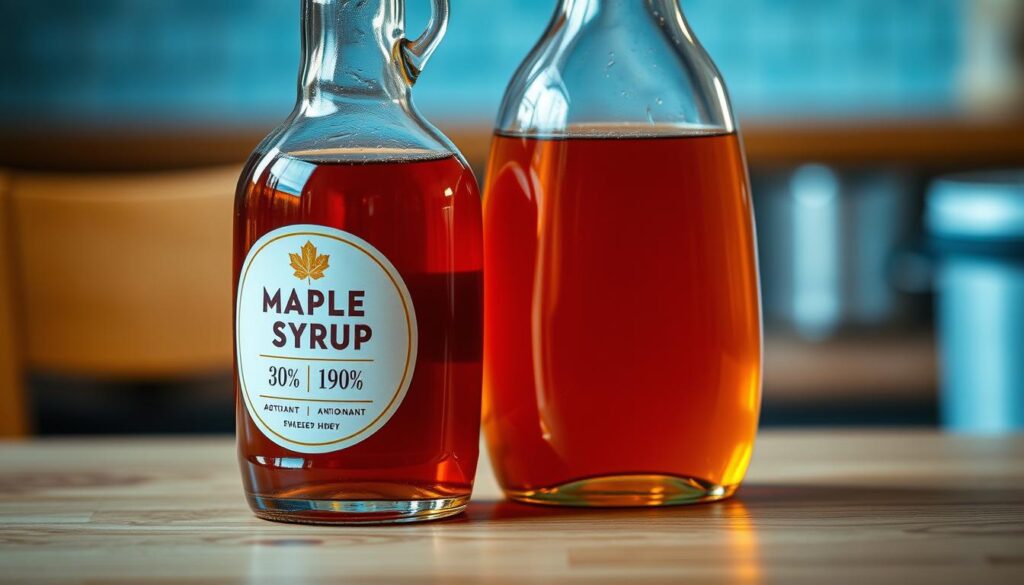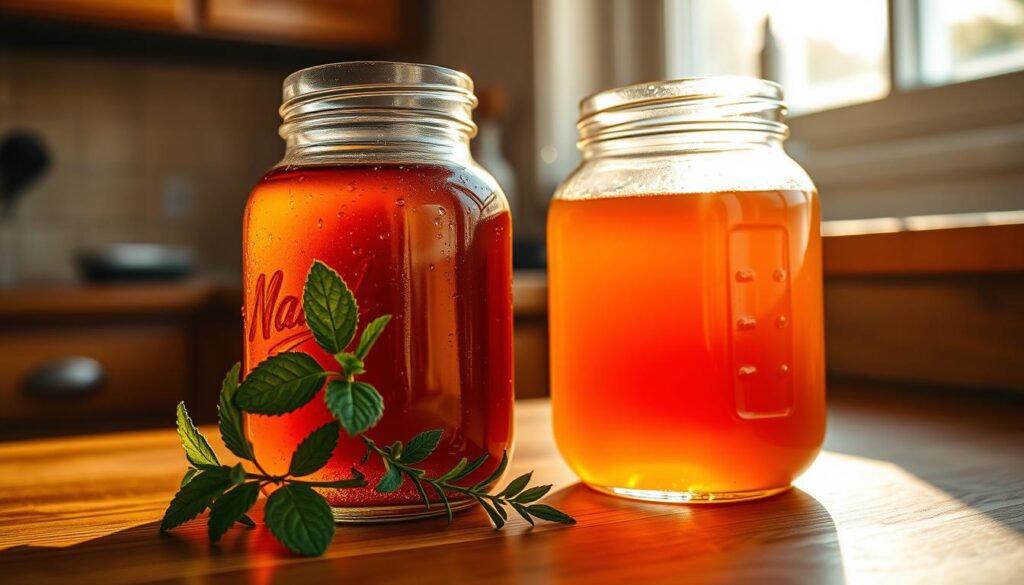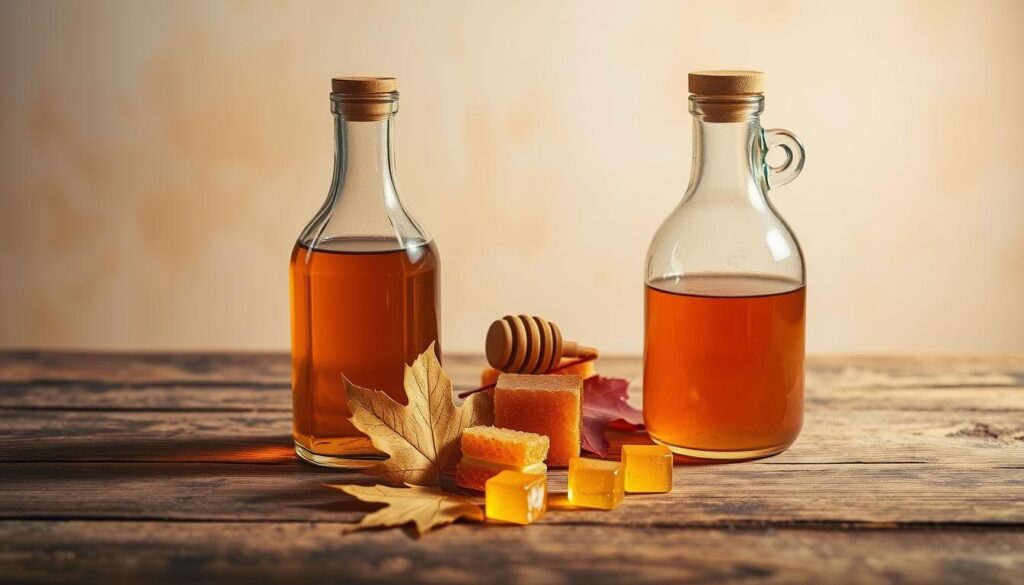Natural sweeteners are getting a lot of attention from people who care about their health. They’re looking for something better than regular sugar. The question “Is Maple Syrup Healthier than Honey?” is a big topic among those who love food and health.
Looking at maple syrup and honey is like exploring two amazing natural sweeteners. They add more than just sweetness to our food. Their stories of how they’re made and what they contain are quite interesting.
In Vermont, sugarmakers and in California, beekeepers know a lot about their products. They use old ways to make these sweeteners from tree sap and flower nectar. This makes them special and full of nutrients.
When we compare maple syrup and honey, we look at many things. We check their nutrition, how they affect blood sugar, their minerals, and health benefits. Today, people want foods that are good for them, not just tasty.
This guide will show you the differences between maple syrup and honey. We’ll look at where they come from, how they’re made, and their health effects. You’ll learn a lot about these natural sweeteners.
If you’re into health, cooking, or just curious about food, this is for you. You’ll find out some surprising things about maple syrup and honey.
Understanding Natural Sweeteners: A Brief Introduction
Natural sweeteners have become popular among health-conscious people. They look for alternatives to refined sugar. Maple syrup and honey are now seen as nutritious choices.
The world of sweeteners has changed a lot. People are moving away from artificial sugars. They prefer natural options that taste good and might be good for their health.
The Rising Popularity of Natural Sugar Alternatives
More and more people are interested in natural sweeteners. The benefits of maple syrup and honey are leading this change:
- Minimally processed ingredients
- Rich nutritional profiles
- Lower glycemic impact compared to refined sugars
- Potential medicinal properties
“Nature provides the most elegant solutions to our nutritional needs” – Traditional Food Wisdom
Traditional Uses in Different Cultures
For centuries, cultures worldwide have valued natural sweeteners. Native Americans first made maple syrup by tapping trees. Honey was used in ancient Egypt, Greece, and China for its healing powers.
Honey’s benefits go beyond just being sweet. It was used in traditional medicine for many health issues. This shows how important it was in different cultures.
The Natural Production Process of Maple Syrup
Maple syrup production is a journey that turns tree sap into a sweet treat. It starts in late winter and early spring when maple trees wake up. Sugarmakers pick mature trees, like sugar maples, that are at least 40 years old and 10 inches wide.
The harvesting method is careful. Producers drill holes in the tree bark and put in spiles. These spiles let the sap flow into buckets or through a tubing system.
- Ideal tapping season: Late February to early April
- Best temperature range: 40°F during day, 20°F at night
- Average tree produces 10-20 gallons of sap per season
Boiling is a key step. The sap is heated in large evaporators. Water evaporates, making the liquid thick and syrupy. It takes about 40 gallons of sap to make one gallon of syrup.
| Syrup Grade | Color | Flavor Profile |
|---|---|---|
| Golden | Light | Delicate, mild taste |
| Amber | Medium | Rich, smooth flavor |
| Dark | Deep | Strong, robust taste |
Today’s sugarmakers use new methods but keep traditional skills alive. Making syrup is a mix of skill, patience, and knowing nature’s rhythms. It turns simple sap into a valuable food ingredient.
How Bees Make Honey: Nature’s Sweet Creation
Honey production is a complex natural process. It turns flower nectar into a sweet treat. Worker bees go on amazing journeys to collect nectar from thousands of flowers. They make one of nature’s most complex foods.
Bees collect nectar in a cool way. They use their long tongues, called proboscises, to get sweet liquid from flowers. A single bee might visit 50-100 flowers on one trip.
Types of Honey and Their Origins
Different honeys come from different flowers. Each honey has its own special taste and smell:
- Wildflower Honey: Collected from many flowers
- Clover Honey: Mild, light-colored
- Manuka Honey: Known for health benefits
- Buckwheat Honey: Has a dark, rich taste
| Honey Type | Color | Flavor Profile |
|---|---|---|
| Wildflower | Light Amber | Balanced, Versatile |
| Manuka | Dark Amber | Strong, Medicinal |
| Clover | Pale Gold | Sweet, Delicate |
Raw vs. Processed Honey
Raw honey is straight from the honeycomb. It’s not filtered or heated. Processed honey is filtered and pasteurized. This can lose some of its natural goodness.
“Honey is liquid gold from nature’s most diligent workers” – Anonymous Beekeeper
The honey-making process shows how bees work together. They turn simple nectar into a food full of nutrients. It’s a remarkable example of nature’s engineering.
Nutritional Profile of Pure Maple Syrup
Pure maple syrup is a natural sweetener with unique nutritional benefits. It’s not just for breakfast; it’s packed with more than sweetness. Its nutritional profile is complex and surprising to many.
Maple syrup is rich in minerals and antioxidants. This makes it stand out from other sweeteners. Here are some key nutrients found in maple syrup:
- Zinc: Supports immune function
- Manganese: Promotes bone health
- Calcium: Strengthens bones and teeth
- Potassium: Regulates heart and muscle function
The nutritional content varies by maple syrup grade. Dark grades have more minerals and a stronger flavor than lighter ones.
| Nutrient | Amount per 1/4 cup | Percentage Daily Value |
|---|---|---|
| Manganese | 0.5 mg | 33% |
| Zinc | 0.2 mg | 2% |
| Calcium | 20 mg | 2% |
| Potassium | 40 mg | 1% |
Maple syrup contains a compound called quebecol. It has anti-inflammatory properties. This makes maple syrup unique among natural sweeteners.
“Maple syrup is not just a sweetener, but a nutrient-rich natural food” – Nutrition Researchers
Knowing about maple syrup’s nutrition helps us make better food choices. It shows its value beyond just being a sweetener.
Honey’s Complex Nutritional Composition
Honey is a natural wonder with a complex mix of nutrients. It’s not just sweet; it’s a treasure trove of health benefits. This golden liquid is packed with compounds that support well-being.
Honey’s unique makeup includes key elements that boost its health benefits:
- Natural sugars like glucose and fructose
- Essential vitamins and minerals
- Trace enzymes and antioxidants
- Beneficial amino acids
Enzymes and Beneficial Compounds
Honey has enzymes that make it even more nutritious. Invertase and glucose oxidase break down sugars into useful compounds. This shows honey’s complex biology.
Antibacterial Properties of Honey
Honey’s antibacterial powers are truly remarkable. Some honeys, like Manuka, have special compounds for healing wounds and fighting infections. Its hydrogen peroxide and low moisture help preserve and heal.
Nature’s sweet medicine: Honey offers more than just flavor—it’s a complex nutritional treasure.
Honey’s rich nutritional profile explains its long-standing value. It’s a natural sweetener that delights the taste buds and offers health benefits.
Is Maple Syrup Healthier Than Honey?
When we look at maple syrup and honey, nutritionists say both have their own health perks. Figuring out if maple syrup is better than honey is complex. It’s not just about comparing them.
Experts say the choice between maple syrup and honey depends on your diet and health goals. Both offer unique benefits:
- Natural sugar alternatives with trace minerals
- Potential antioxidant properties
- Lower processed sugar content compared to refined sweeteners
Is maple syrup healthier than honey? It’s not a simple yes or no. Each has its own nutritional strengths.
| Characteristic | Maple Syrup | Honey |
|---|---|---|
| Primary Nutrients | Manganese, Zinc | Potassium, Calcium |
| Antioxidant Levels | 24 beneficial compounds | 17 beneficial compounds |
| Glycemic Impact | Slightly Lower | Moderate |
“Nature’s sweeteners are not about competition, but understanding their unique nutritional profiles.” – Nutrition Research Institute
Remember, it’s all about moderation with natural sweeteners. Both maple syrup and honey can fit into a healthy diet if used in small amounts.
Glycemic Index Comparison: Impact on Blood Sugar
It’s important to know how maple syrup and honey affect blood sugar. This is key for those watching their diet. Glycemic index is a big factor in choosing the better natural sweetener for health.
The glycemic index (GI) shows how fast a food raises blood sugar. Maple syrup and honey have different effects on blood sugar. This makes their nutritional values unique.
| Sweetener | Glycemic Index | Blood Sugar Impact |
|---|---|---|
| Pure Maple Syrup | 54 | Moderate |
| Honey | 58 | Slightly Higher |
Managing Blood Sugar with Natural Sweeteners
When deciding between maple syrup and honey, think about portion size and diet balance. Both can fit into a healthy diet if used wisely.
- Choose pure, unprocessed varieties
- Use in moderation
- Pair with protein or fiber to slow sugar absorption
Nutrition experts recommend selecting natural sweeteners that provide additional health benefits beyond simple calories.
People with diabetes or watching their blood sugar should talk to their doctor about these sweeteners. Individual metabolic responses can vary, so getting personalized advice is key.
Antioxidant Properties: Maple Syrup vs. Honey

Looking into maple syrup and honey shows how they fight off free radicals. Both are natural sweeteners with strong antioxidant powers. They help protect our bodies from harm.
Maple syrup has a special mix of antioxidants. Studies show it has up to 24 different kinds, including polyphenols. Dark maple syrups have more antioxidants than lighter ones.
- Maple Syrup Antioxidant Highlights:
- Rich in phenolic compounds
- Contains quebecol, a rare antioxidant unique to maple syrup
- Higher antioxidant capacity than some fruits and vegetables
Honey also has its own set of antioxidants. The type of honey affects its antioxidant level. Darker honeys, like buckwheat, have more antioxidants.
“Nature’s sweeteners are more than just sugar – they’re powerful health allies.” – Nutritional Science Research
When we compare their antioxidants, maple syrup often wins. It has more antioxidants than honey. Maple syrup is not just sweet; it’s also nutritious.
- Honey Antioxidant Characteristics:
- Flavonoids and phenolic acids present
- Antioxidant levels vary by flower source
- Raw honey maintains higher antioxidant content
Choosing between maple syrup and honey depends on what you want. Both offer great health benefits. They’re more than just sugar substitutes.
Mineral Content and Essential Nutrients
Natural sweeteners like maple syrup and honey are more than tasty treats. They are packed with essential minerals that boost our health. Learning about the mineral content in maple syrup and honey shows their hidden health benefits.
Maple syrup and honey have unique mineral profiles. This makes them different from refined sugars. Their nutrient content changes based on where they are made and how they are produced.
Trace Elements in Maple Syrup
Maple syrup is known for its rich mineral content. It includes:
- Manganese: Important for bone health and metabolism
- Zinc: Helps the immune system
- Calcium: Keeps bones and teeth strong
- Potassium: Helps the heart and muscles
Mineral Diversity in Honey
Honey is a treasure trove of minerals, including:
- Iron: Crucial for blood health
- Calcium: Strengthens bones and teeth
- Magnesium: Supports nerves and muscles
- Phosphorus: Helps with cellular repair
| Mineral | Maple Syrup (per 100g) | Honey (per 100g) |
|---|---|---|
| Manganese | 2.9 mg | 0.05 mg |
| Zinc | 0.4 mg | 0.22 mg |
| Calcium | 102 mg | 6 mg |
| Iron | 0.2 mg | 0.42 mg |
Nutrition experts say these minerals are good, but they should be part of a balanced diet. Maple syrup and honey should not be the main source of minerals.
“Nature’s sweeteners are more than just sugar – they’re complex nutritional powerhouses.” – Nutritional Research Institute
Caloric Content and Sugar Composition
Looking at maple syrup vs honey nutrition shows interesting differences. Both are high in energy, but they have different nutritional values.
Maple syrup has about 52 calories per tablespoon. Honey has 64-65 calories in the same amount. It’s not just about the calories, but the quality of energy they provide.
- Maple Syrup Sugar Breakdown:
- Primarily sucrose (around 90%)
- Minimal glucose and fructose
- Honey Sugar Composition:
- Higher fructose content
- More diverse sugar profile
Is Maple Syrup Healthier than Honey? The sugar makeup is key. Maple syrup has less simple sugars than honey. This might make it a better choice for your metabolism.
Both sweeteners give more than just calories. They have trace minerals, antioxidants, and special compounds. These are different from refined sugar. The body handles them in unique ways, giving more than just energy.
Culinary Applications and Cooking Properties
Natural sweeteners like maple syrup and honey add special flavors to cooking and baking. They are not just for sweetening tables. They offer many options for both home cooks and professional chefs.
Maple syrup shines in many cooking methods. Its deep, caramel-like taste is great for:
- Baking sweet breads and muffins
- Glazing roasted vegetables
- Creating marinades for meats
- Sweetening breakfast dishes
Temperature Stability in Cooking
Maple syrup is very stable when heated. Professional chefs love it because it caramelizes fast without burning. This makes it perfect for cooking at high temperatures.
Honey also has amazing uses in cooking. Its ability to keep moisture in makes it great for:
- Creating moist baked goods
- Developing complex flavor profiles
- Enhancing salad dressings
- Adding depth to sauces
Both maple syrup and honey can replace refined sugar in recipes. But, you might need to adjust the liquid content for the best results.
Storage Guidelines and Shelf Life

Storing maple syrup and honey right is key to keeping their taste and quality. These natural sweeteners need special care to keep their unique flavors and health benefits.
For maple syrup, keeping it in the fridge is important to stop it from going bad. An unopened bottle can last up to two years in a cool, dark spot. After opening, maple syrup should stay in the fridge and be used within six months.
- Store maple syrup in glass or food-grade plastic containers
- Keep away from direct sunlight and heat sources
- Always use clean utensils when scooping
Honey has a longer shelf life because of its natural preservatives. Crystallization is a natural process that doesn’t mean it’s gone bad.
- Store honey at room temperature
- Seal containers tightly
- Avoid moisture exposure
To fix honey crystallization, warm the container in a water bath. For maple syrup, always check for mold before using. A thin layer of mold can be safely removed by skimming it off and boiling the syrup.
Pro tip: Clean, airtight containers are essential for preserving the quality of both maple syrup and honey.
Environmental Impact and Sustainability
Natural sweeteners like maple syrup and honey are key to sustainable farming. Their making ways greatly affect the health of ecosystems and biodiversity. They offer special benefits for the environment, beyond just being tasty.
Maple syrup and honey making help the environment by using smart farming methods. Sugarmakers and beekeepers work with nature to help wildlife and keep the environment balanced.
Ecological Footprint of Production Methods
Different ways of making these sweeteners show us interesting environmental facts:
- Maple syrup harvesting helps save forests
- Beekeeping boosts pollination and plant variety
- Both cut down on harm from big farms
| Production Aspect | Maple Syrup | Honey |
|---|---|---|
| Land Use | Forest preservation | Wildflower meadows |
| Carbon Emissions | Low-impact harvesting | Minimal processing |
| Biodiversity Support | Forest ecosystem maintenance | Pollination enhancement |
Getting organic certifications and using green practices means these natural sweeteners are not just yummy. They also help protect our planet for the next generations.
Identifying Pure vs. Artificial Products
Finding the real deal in maple syrup and honey can be tough. It’s important to know how to spot the difference. This means looking for certain signs that show if a product is genuine or not.
For pure maple syrup, check these key points:
- Single ingredient on label: Pure maple syrup
- Grade certification from official maple producers
- Color variation indicating natural processing
- No added sugars or artificial flavors
Identifying real honey is similar. Look for these signs:
- Viscous, slow-moving texture
- Natural crystallization over time
- Specific gravity test (pure honey sinks)
- Single-source or regional origin labeling
Groups like the USDA help with labeling rules for natural sweeteners. They make sure products are labeled correctly. Always check the packaging for ingredient lists. Stay away from products with many sugars or chemicals.
Authentic natural sweeteners reflect the complex processes of nature, from maple tree sap collection to bee pollination.
Buying from trusted local makers or certified organic brands is a good idea. This way, you get the best maple syrup and honey.
Health Considerations and Dietary Restrictions
When deciding between maple syrup and honey, knowing about health benefits is key. Both have different effects on our well-being.
People with certain dietary needs should think twice before using these sweeteners. Is Maple Syrup Healthier than Honey? It really depends on your health and what you need to eat.
Dietary Restrictions and Allergies
Health conditions affect how we can use maple syrup and honey. Important health points include:
- Diabetes management
- Blood sugar sensitivity
- Potential allergic reactions
- Infant dietary restrictions
Honey is risky for babies under one because of botulism spores. Maple syrup is safer for young kids.
| Health Condition | Maple Syrup Impact | Honey Impact |
|---|---|---|
| Diabetes | Lower glycemic index | Higher sugar content |
| Allergies | Minimal allergenic risk | Higher allergy risk |
| Infant Safety | Generally safe | Botulism risk |
Nutritional Sensitivities
People with special diets should think about their needs. Vegan, paleo, and low-sugar diets affect maple syrup and honey differently.
Talking to a doctor is the best way to know if these sweeteners are right for you.
Conclusion
Exploring if maple syrup is healthier than honey shows a complex view of natural sweeteners. Is Maple Syrup Healthier than Honey? The answer is not simple. Both maple syrup and honey have their own nutritional benefits that fit different diets and health goals.
Maple syrup vs honey nutrition shows each has its own advantages. Maple syrup is rich in minerals and antioxidants. Honey, on the other hand, has antibacterial properties and complex enzymes. Experts say the healthier choice depends on personal health needs, taste, and diet.
The main point is to eat in moderation. Even though natural sweeteners are better than refined sugars, they should be enjoyed carefully. People should think about more than just nutrition, like how they’re made and their impact on health, when picking a natural sweetener.
Knowing the special qualities of maple syrup and honey helps us make better choices. This world of natural sweeteners is full of flavors, health perks, and cultural importance. It’s waiting for us to discover.



